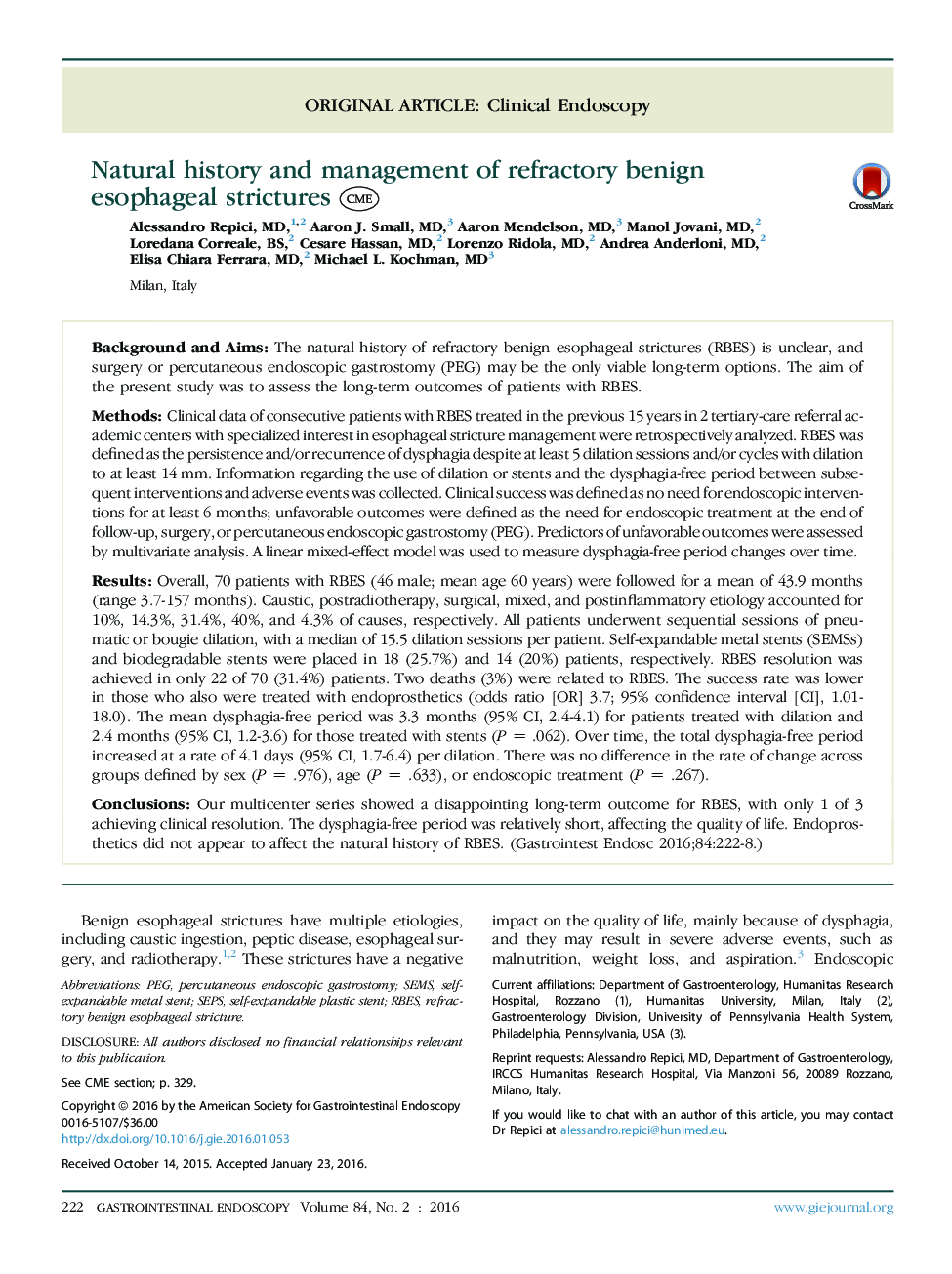| کد مقاله | کد نشریه | سال انتشار | مقاله انگلیسی | نسخه تمام متن |
|---|---|---|---|---|
| 3302090 | 1210287 | 2016 | 7 صفحه PDF | دانلود رایگان |
Background and AimsThe natural history of refractory benign esophageal strictures (RBES) is unclear, and surgery or percutaneous endoscopic gastrostomy (PEG) may be the only viable long-term options. The aim of the present study was to assess the long-term outcomes of patients with RBES.MethodsClinical data of consecutive patients with RBES treated in the previous 15 years in 2 tertiary-care referral academic centers with specialized interest in esophageal stricture management were retrospectively analyzed. RBES was defined as the persistence and/or recurrence of dysphagia despite at least 5 dilation sessions and/or cycles with dilation to at least 14 mm. Information regarding the use of dilation or stents and the dysphagia-free period between subsequent interventions and adverse events was collected. Clinical success was defined as no need for endoscopic interventions for at least 6 months; unfavorable outcomes were defined as the need for endoscopic treatment at the end of follow-up, surgery, or percutaneous endoscopic gastrostomy (PEG). Predictors of unfavorable outcomes were assessed by multivariate analysis. A linear mixed-effect model was used to measure dysphagia-free period changes over time.ResultsOverall, 70 patients with RBES (46 male; mean age 60 years) were followed for a mean of 43.9 months (range 3.7-157 months). Caustic, postradiotherapy, surgical, mixed, and postinflammatory etiology accounted for 10%, 14.3%, 31.4%, 40%, and 4.3% of causes, respectively. All patients underwent sequential sessions of pneumatic or bougie dilation, with a median of 15.5 dilation sessions per patient. Self-expandable metal stents (SEMSs) and biodegradable stents were placed in 18 (25.7%) and 14 (20%) patients, respectively. RBES resolution was achieved in only 22 of 70 (31.4%) patients. Two deaths (3%) were related to RBES. The success rate was lower in those who also were treated with endoprosthetics (odds ratio [OR] 3.7; 95% confidence interval [CI], 1.01-18.0). The mean dysphagia-free period was 3.3 months (95% CI, 2.4-4.1) for patients treated with dilation and 2.4 months (95% CI, 1.2-3.6) for those treated with stents (P = .062). Over time, the total dysphagia-free period increased at a rate of 4.1 days (95% CI, 1.7-6.4) per dilation. There was no difference in the rate of change across groups defined by sex (P = .976), age (P = .633), or endoscopic treatment (P = .267).ConclusionsOur multicenter series showed a disappointing long-term outcome for RBES, with only 1 of 3 achieving clinical resolution. The dysphagia-free period was relatively short, affecting the quality of life. Endoprosthetics did not appear to affect the natural history of RBES.
Journal: Gastrointestinal Endoscopy - Volume 84, Issue 2, August 2016, Pages 222–228
